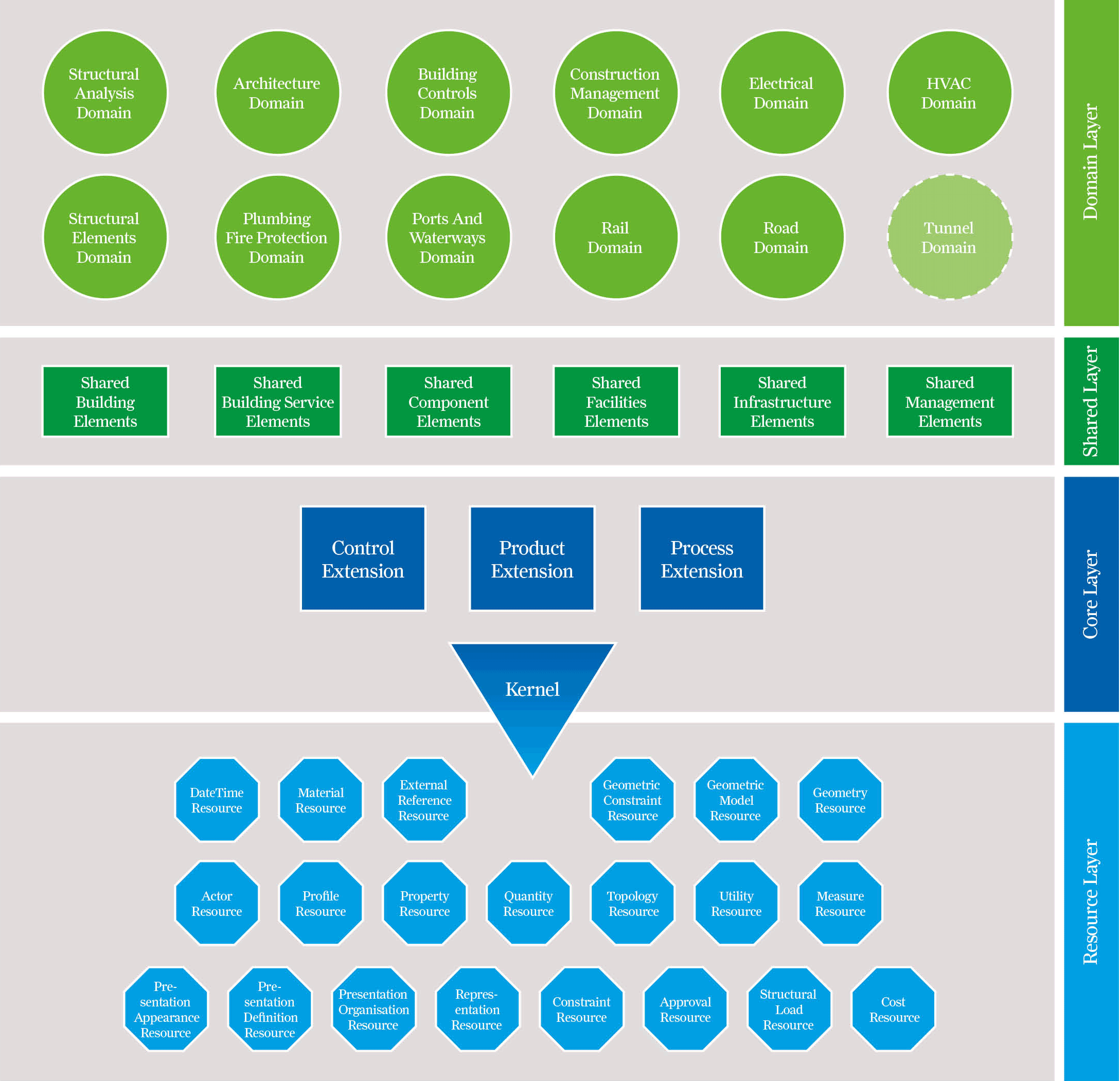Tim Davies, buildingSMART UK & Ireland committee member and UK Construction Room lead, takes a look at the constituent parts of the data model specification that enables interoperability in the AECO industry
What a lovely combination of circles, rectangles, squares, octagons, and an inverted triangle there is in the diagram left. It sort of reminds me of a kid’s shapes exercise from school. But of course it’s much more than that; it’s actually a diagram showing how to represent what we do in the AEC industry in a digital way. In this article I’m going dig a bit more into what each part of the diagram means.
IFC is like an onion
IFC has layers, and once you start to peel those layers back, it might make you cry if you don’t know what you’re doing.
Each layer builds upon the layer below, so I’m going to talk about each layer in the opposite order than shown in the diagram. The list below is ordered from most generic layer to the most specific layer:
- Resource Layer
Generic things not specific to AEC - Core Layer
The most basic things in AEC - Shared Layer
Things common to many disciplines - Domain Layer
Things specific to one discipline
Let’s go through each layer.

Resource Layer
This is where the basic building blocks live, and I mean the absolute basics.
For example:
- Units definitions
- Shape / geometry
- Date and time descriptions
- Money and currencies
- Property data types
Almost none of these things are specific to AEC. A lot of these things could apply to almost any other industry in the world.
There are some hints of our industry though. For example, there’s a bunch of structural loading objects which are only really useful for structural engineering.
Core Layer
Again, a lot of the things here are still very generic. Here we have basic objects, property sets, and different types of relationships, all of which could apply to any industry.
In this layer you have lots of lovely academic language like:
It captures general constructs, that are basically founded by their different semantic meaning in common understanding of an object model.
That’s not to understate its importance. Like everyone in AEC knows, every building starts, literally, with a good foundation to build upon. The Resource and Core layers are the digital foundations for the AEC industry.
Shared Layer
This is where things get more down to earth and contains the most common objects in AEC. It’s in this layer you’ll find physical things such as walls, stairs, windows, fasteners, earthworks, and MEP fittings. There’s also some broad things such as definitions for management and facilities, such as permits, cost schedules, furniture and occupants.
Domain Layer
Finally, the Domain Layer is where the discipline specific things live.
As of version 4.3, IFC covers a lot of disciplines. These disciplines are:
- Architecture
- Building controls
- Construction management
- Electrical
- HVAC
- Plumbing
- Ports and waterways
- Rail
- Road
- Structural
- Tunnel (work in progress)
I’m sure everyone can agree this is a pretty extensive list. This would cover most AEC projects, and for those that it doesn’t
cover there are probably groups in buildingSMART working to cover more.
The Shared and Domain layer are the layers that AEC professionals would recognise. In fact, if one was to teach IFC, it may actually make sense to start off at these layers and work backwards. Otherwise, there’s a good chance people will get lost and turned off by the highly abstract nature.
Summary
What we’ve learned here is that the IFC schema is made up of a number of layers, ranging from highly generic to discipline specific. These layers are called the Resource, Core, Shared, and Domain. Between them, it’s possible to describe most things you’d ever want to describe in the AEC industry in a digital way.
This article first appeared on Tim Davies’s blog
Watch Emma Hooper’s NXT BLD 2022 talk on Information Models and the future of IFC. Register FREE
To learn more about IFC, read AEC’s Magazine’s IFC Special Report, produced in collaboration with buildingSMART United Kingdom & Ireland. See page 67 onwards.






